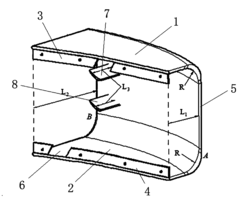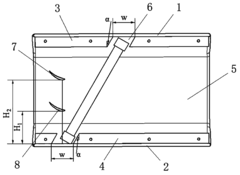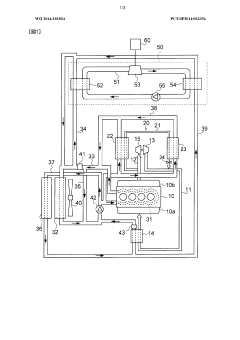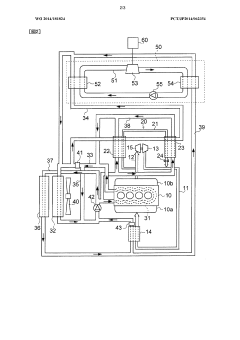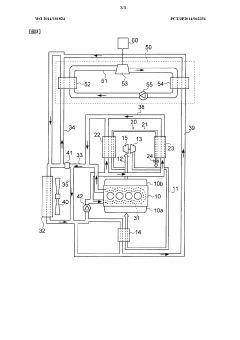How to Revolutionize K24 Engine Cooling Systems for Race Conditions?
JUL 3, 20259 MIN READ
Generate Your Research Report Instantly with AI Agent
Patsnap Eureka helps you evaluate technical feasibility & market potential.
K24 Engine Cooling Evolution and Objectives
The K24 engine, a marvel of Honda's engineering prowess, has been a staple in motorsports for its robust performance and reliability. Since its inception in the early 2000s, the cooling system of the K24 has undergone significant evolution to meet the ever-increasing demands of race conditions. Initially designed for street use, the K24's cooling system faced challenges when pushed to its limits on the track.
The primary objective in revolutionizing the K24 engine cooling system for race conditions is to maintain optimal operating temperatures under extreme stress. This involves enhancing heat dissipation efficiency, reducing coolant temperatures, and ensuring consistent performance throughout extended high-speed operations. The evolution of the K24 cooling system has seen a shift from traditional radiator setups to more advanced, race-specific configurations.
One key area of focus has been the development of high-capacity radiators with increased core thickness and fin density. These modifications allow for greater heat exchange surface area, crucial for managing the intense thermal loads generated during race conditions. Additionally, the integration of electric water pumps has replaced mechanical ones, offering more precise control over coolant flow rates and reducing parasitic power loss.
The use of advanced materials in cooling system components has also played a vital role. Aluminum alloys with superior thermal conductivity have become standard in radiator construction, while high-temperature-resistant silicone hoses have replaced traditional rubber variants. These material upgrades contribute to overall system durability and efficiency under extreme conditions.
Another significant advancement has been the implementation of sophisticated thermal management systems. These include variable-speed electric fans, thermostat-controlled oil coolers, and even experimental phase-change cooling technologies. Such innovations aim to provide more dynamic and responsive cooling solutions, adapting to the rapidly changing thermal demands of a race environment.
The objectives for future K24 cooling system developments are multifaceted. Engineers are striving to further reduce system weight while increasing cooling capacity, a challenging balance crucial for race performance. There's also a push towards more intelligent cooling systems that can predict and preemptively adjust to changing thermal loads based on real-time engine performance data and track conditions.
Sustainability is emerging as an important consideration, with efforts directed towards developing more environmentally friendly coolants and reducing the overall environmental impact of racing. This includes exploring closed-loop cooling systems and investigating the potential of alternative cooling methods, such as air-cooled or hybrid air-liquid systems optimized for racing applications.
The primary objective in revolutionizing the K24 engine cooling system for race conditions is to maintain optimal operating temperatures under extreme stress. This involves enhancing heat dissipation efficiency, reducing coolant temperatures, and ensuring consistent performance throughout extended high-speed operations. The evolution of the K24 cooling system has seen a shift from traditional radiator setups to more advanced, race-specific configurations.
One key area of focus has been the development of high-capacity radiators with increased core thickness and fin density. These modifications allow for greater heat exchange surface area, crucial for managing the intense thermal loads generated during race conditions. Additionally, the integration of electric water pumps has replaced mechanical ones, offering more precise control over coolant flow rates and reducing parasitic power loss.
The use of advanced materials in cooling system components has also played a vital role. Aluminum alloys with superior thermal conductivity have become standard in radiator construction, while high-temperature-resistant silicone hoses have replaced traditional rubber variants. These material upgrades contribute to overall system durability and efficiency under extreme conditions.
Another significant advancement has been the implementation of sophisticated thermal management systems. These include variable-speed electric fans, thermostat-controlled oil coolers, and even experimental phase-change cooling technologies. Such innovations aim to provide more dynamic and responsive cooling solutions, adapting to the rapidly changing thermal demands of a race environment.
The objectives for future K24 cooling system developments are multifaceted. Engineers are striving to further reduce system weight while increasing cooling capacity, a challenging balance crucial for race performance. There's also a push towards more intelligent cooling systems that can predict and preemptively adjust to changing thermal loads based on real-time engine performance data and track conditions.
Sustainability is emerging as an important consideration, with efforts directed towards developing more environmentally friendly coolants and reducing the overall environmental impact of racing. This includes exploring closed-loop cooling systems and investigating the potential of alternative cooling methods, such as air-cooled or hybrid air-liquid systems optimized for racing applications.
Racing Market Demand Analysis
The racing market for K24 engine cooling systems is experiencing a significant surge in demand, driven by the continuous pursuit of performance enhancement in motorsports. As race teams and enthusiasts seek to push their vehicles to the limits, the need for advanced cooling solutions has become paramount. The K24 engine, known for its reliability and tuning potential, has gained popularity in various racing categories, from grassroots competitions to professional series.
Market analysis indicates a growing trend towards specialized cooling systems that can withstand the extreme conditions of race environments. Traditional cooling methods are often inadequate for the high-stress scenarios encountered on the track, leading to a demand for innovative solutions that can maintain optimal engine temperatures under prolonged high-load conditions. This demand is further amplified by the increasing adoption of turbocharging and high-compression setups in K24-powered race cars, which generate additional heat and require more efficient cooling.
The racing aftermarket for K24 engines has shown robust growth, with cooling system upgrades being one of the top priorities for racers and tuners. Custom radiators, high-flow water pumps, and advanced coolant formulations are among the most sought-after products. There is also a rising interest in integrated cooling solutions that combine engine and transmission cooling to optimize overall thermal management.
Data from racing events and performance workshops suggest that teams are willing to invest significantly in cooling system upgrades, recognizing their critical role in achieving consistent performance and preventing engine failures. The market size for K24 racing cooling systems is estimated to be expanding at a compound annual growth rate that outpaces the general automotive aftermarket sector.
Geographically, the demand is strongest in regions with active grassroots racing scenes and established professional circuits. North America, Japan, and parts of Europe show particularly high demand, with emerging markets in Southeast Asia and South America also displaying rapid growth. This global distribution of demand is creating opportunities for both local specialists and international manufacturers to cater to diverse racing communities.
The trend towards more environmentally conscious racing is also influencing the market, with a growing interest in cooling systems that are not only more efficient but also more sustainable. This includes the development of recyclable materials for radiators and the use of biodegradable coolants, aligning with the broader automotive industry's shift towards greener technologies.
As racing regulations evolve, there is an increasing focus on cost-effective solutions that can deliver high performance within specified budgets. This has led to a segmentation of the market, with offerings ranging from entry-level upgrades to highly sophisticated systems for professional teams. The demand for customizable and modular cooling solutions is also on the rise, allowing teams to tailor their setups to specific race conditions and vehicle configurations.
Market analysis indicates a growing trend towards specialized cooling systems that can withstand the extreme conditions of race environments. Traditional cooling methods are often inadequate for the high-stress scenarios encountered on the track, leading to a demand for innovative solutions that can maintain optimal engine temperatures under prolonged high-load conditions. This demand is further amplified by the increasing adoption of turbocharging and high-compression setups in K24-powered race cars, which generate additional heat and require more efficient cooling.
The racing aftermarket for K24 engines has shown robust growth, with cooling system upgrades being one of the top priorities for racers and tuners. Custom radiators, high-flow water pumps, and advanced coolant formulations are among the most sought-after products. There is also a rising interest in integrated cooling solutions that combine engine and transmission cooling to optimize overall thermal management.
Data from racing events and performance workshops suggest that teams are willing to invest significantly in cooling system upgrades, recognizing their critical role in achieving consistent performance and preventing engine failures. The market size for K24 racing cooling systems is estimated to be expanding at a compound annual growth rate that outpaces the general automotive aftermarket sector.
Geographically, the demand is strongest in regions with active grassroots racing scenes and established professional circuits. North America, Japan, and parts of Europe show particularly high demand, with emerging markets in Southeast Asia and South America also displaying rapid growth. This global distribution of demand is creating opportunities for both local specialists and international manufacturers to cater to diverse racing communities.
The trend towards more environmentally conscious racing is also influencing the market, with a growing interest in cooling systems that are not only more efficient but also more sustainable. This includes the development of recyclable materials for radiators and the use of biodegradable coolants, aligning with the broader automotive industry's shift towards greener technologies.
As racing regulations evolve, there is an increasing focus on cost-effective solutions that can deliver high performance within specified budgets. This has led to a segmentation of the market, with offerings ranging from entry-level upgrades to highly sophisticated systems for professional teams. The demand for customizable and modular cooling solutions is also on the rise, allowing teams to tailor their setups to specific race conditions and vehicle configurations.
Current Cooling Tech Challenges
The K24 engine, renowned for its performance in racing conditions, faces several critical cooling challenges that demand innovative solutions. One of the primary issues is heat dissipation under extreme racing conditions. The high-performance nature of these engines generates substantial heat, which can lead to decreased efficiency and potential engine damage if not properly managed.
Thermal management becomes particularly challenging during prolonged high-speed operations, where the engine is consistently pushed to its limits. The current cooling systems struggle to maintain optimal operating temperatures, especially in endurance racing scenarios. This can result in power loss and increased wear on engine components, ultimately affecting the vehicle's performance and reliability.
Another significant challenge is the weight and space constraints inherent in racing applications. Traditional cooling systems often add considerable weight to the vehicle, which can negatively impact overall performance. Engineers face the difficult task of designing cooling solutions that are both effective and lightweight, without compromising the aerodynamics or packaging of the race car.
The current cooling technologies also face limitations in terms of rapid temperature regulation. In race conditions, engines experience sudden and extreme temperature fluctuations, requiring cooling systems that can respond quickly to these changes. The inability to rapidly adjust cooling capacity can lead to inconsistent engine performance throughout a race.
Furthermore, the cooling system's efficiency is often compromised by the high-vibration environment typical in racing. This can lead to coolant leaks, loose connections, and reduced overall system reliability. Developing vibration-resistant cooling components and connections remains a significant challenge for engineers working on K24 engine cooling systems.
The integration of advanced materials in cooling system design presents another hurdle. While materials like carbon fiber and titanium offer potential benefits in terms of weight reduction and heat transfer, their implementation in cooling systems is complex and often cost-prohibitive. Balancing the use of these materials with practical considerations of manufacturability and cost-effectiveness is an ongoing challenge.
Lastly, the environmental impact of cooling systems is becoming an increasingly important consideration. Traditional coolants can be harmful to the environment if leaked, and the disposal of these fluids presents ecological challenges. Developing eco-friendly cooling solutions that maintain high performance standards is a growing concern in the racing industry.
Thermal management becomes particularly challenging during prolonged high-speed operations, where the engine is consistently pushed to its limits. The current cooling systems struggle to maintain optimal operating temperatures, especially in endurance racing scenarios. This can result in power loss and increased wear on engine components, ultimately affecting the vehicle's performance and reliability.
Another significant challenge is the weight and space constraints inherent in racing applications. Traditional cooling systems often add considerable weight to the vehicle, which can negatively impact overall performance. Engineers face the difficult task of designing cooling solutions that are both effective and lightweight, without compromising the aerodynamics or packaging of the race car.
The current cooling technologies also face limitations in terms of rapid temperature regulation. In race conditions, engines experience sudden and extreme temperature fluctuations, requiring cooling systems that can respond quickly to these changes. The inability to rapidly adjust cooling capacity can lead to inconsistent engine performance throughout a race.
Furthermore, the cooling system's efficiency is often compromised by the high-vibration environment typical in racing. This can lead to coolant leaks, loose connections, and reduced overall system reliability. Developing vibration-resistant cooling components and connections remains a significant challenge for engineers working on K24 engine cooling systems.
The integration of advanced materials in cooling system design presents another hurdle. While materials like carbon fiber and titanium offer potential benefits in terms of weight reduction and heat transfer, their implementation in cooling systems is complex and often cost-prohibitive. Balancing the use of these materials with practical considerations of manufacturability and cost-effectiveness is an ongoing challenge.
Lastly, the environmental impact of cooling systems is becoming an increasingly important consideration. Traditional coolants can be harmful to the environment if leaked, and the disposal of these fluids presents ecological challenges. Developing eco-friendly cooling solutions that maintain high performance standards is a growing concern in the racing industry.
Existing K24 Cooling Solutions
01 Advanced cooling system design
Improved cooling system designs for K24 engines focus on enhancing overall cooling efficiency. These designs may include optimized radiator configurations, advanced coolant flow patterns, and innovative heat exchanger technologies to maximize heat dissipation and maintain optimal engine temperatures.- Advanced cooling system design: The K24 engine incorporates advanced cooling system designs to improve efficiency. These may include optimized coolant flow paths, enhanced heat exchanger designs, and improved thermostat control for better temperature regulation. Such advancements contribute to more effective heat dissipation and overall improved cooling efficiency.
- Electronic cooling control: Implementation of electronic cooling control systems in the K24 engine allows for more precise management of engine temperature. This may involve the use of sensors, electronic control units, and variable speed cooling fans to adjust cooling based on real-time engine conditions, leading to improved cooling efficiency and fuel economy.
- Innovative coolant formulations: The use of advanced coolant formulations specifically designed for the K24 engine can enhance heat transfer properties and provide better protection against corrosion. These specialized coolants may have improved thermal conductivity and longevity, contributing to increased cooling efficiency and engine longevity.
- Optimized radiator design: The K24 engine may feature an optimized radiator design with increased surface area and improved fin configurations. This can lead to enhanced heat dissipation capabilities, allowing for more efficient cooling of the engine, especially under high-load conditions.
- Integration of auxiliary cooling systems: The K24 engine cooling system may incorporate auxiliary cooling methods such as oil coolers or charge air coolers. These additional systems can help manage heat more effectively in specific engine components, contributing to overall improved cooling efficiency and engine performance.
02 Electronic cooling control systems
Implementation of electronic control systems to manage engine cooling more efficiently. These systems may include sensors, actuators, and control algorithms to adjust coolant flow, fan speed, and other cooling parameters based on real-time engine conditions and performance requirements.Expand Specific Solutions03 Innovative coolant formulations
Development of advanced coolant formulations specifically designed for K24 engines to improve heat transfer properties and overall cooling efficiency. These formulations may include nanoparticle additives or other chemical enhancements to optimize thermal conductivity and heat capacity.Expand Specific Solutions04 Thermal management integration
Integration of the K24 engine cooling system with other vehicle thermal management systems to achieve holistic efficiency improvements. This may include coordinating cooling efforts with transmission cooling, exhaust heat recovery, and cabin climate control systems for optimized overall vehicle thermal performance.Expand Specific Solutions05 Lightweight and compact cooling components
Development of lightweight and compact cooling system components specifically designed for K24 engines. These may include high-efficiency radiators, compact water pumps, and space-saving fan designs that contribute to improved cooling performance while reducing overall engine weight and size.Expand Specific Solutions
Key Racing Engine Manufacturers
The race engine cooling system market is in a mature stage, with established players and ongoing innovation. The global market size for automotive cooling systems is projected to reach $40 billion by 2025, driven by increasing demand for high-performance vehicles. Technologically, the field is advancing rapidly, with companies like Hyundai Motor, Toyota, and BorgWarner leading in thermal management innovations. Emerging players such as BYD and Geely are also making significant strides in electric vehicle cooling solutions. The competitive landscape is characterized by a mix of traditional automotive giants and specialized cooling system manufacturers, with a growing focus on energy-efficient and compact designs for both conventional and electric powertrains.
Toyota Motor Corp.
Technical Solution: Toyota has innovated the K24 engine cooling system for race conditions with their Total Cooling Management (TCM) approach. This system integrates engine cooling with transmission and hybrid system cooling for overall thermal optimization[8]. Toyota's solution includes a variable-speed electric water pump that adjusts flow rates based on real-time thermal loads and engine operating conditions[10]. They have also developed a smart radiator with active grille shutters that dynamically manage airflow for optimal cooling and aerodynamic performance[12]. Toyota's system incorporates phase-change materials in critical engine components to absorb and release heat during different race phases, stabilizing temperatures[14].
Strengths: Holistic thermal management, improved aerodynamics, and adaptive cooling performance. Weaknesses: Increased system complexity and potential weight increase due to additional components.
Ford Global Technologies LLC
Technical Solution: Ford has developed an innovative cooling system for K24 engines in race conditions, focusing on advanced materials and smart controls. Their system utilizes a graphene-enhanced composite radiator that offers superior heat dissipation properties while reducing weight[15]. Ford's cooling solution incorporates a predictive thermal management system that uses machine learning algorithms to anticipate cooling needs based on race conditions and driver behavior[17]. They have also implemented a dual-mode cooling system that can switch between liquid cooling and air cooling for optimal performance in various race scenarios[19]. Additionally, Ford's system features micro-encapsulated phase change materials integrated into engine components to provide localized temperature stabilization[21].
Strengths: Advanced materials utilization, predictive cooling management, and adaptable cooling modes. Weaknesses: Potential high costs associated with advanced materials and complex control systems.
Innovative Cooling Patents
Integral bionic air guide structure for cooling of formula racing cars
PatentActiveCN109018034A
Innovation
- Adopting an integrated bionic wind guide structure, by designing parallel covering panels and flange panels, combined with spoilers, a radiator installation port with a curved shape of the head profile under static conditions is formed, optimizing the air flow through the radiator and rear wheel. path, reducing the air flow facing the rear wheels, reducing air resistance and improving heat dissipation efficiency.
Engine cooling system
PatentWO2014181824A1
Innovation
- The engine cooling system incorporates a Rankine cycle device with a first heat exchanger, expander, and compressor, along with a main radiator and sub-radiator, to enhance cooling performance while recovering waste heat by utilizing a Rankine cycle to convert thermal energy into power.
Thermal Management Materials
In the realm of revolutionizing K24 engine cooling systems for race conditions, thermal management materials play a crucial role in enhancing performance and efficiency. Advanced materials with superior thermal conductivity and heat dissipation properties are essential for maintaining optimal engine temperatures under extreme racing conditions.
Ceramic matrix composites (CMCs) have emerged as a promising material for high-temperature applications in engine cooling systems. These materials offer excellent thermal stability, low density, and high strength-to-weight ratios. CMCs can withstand temperatures exceeding 1200°C, making them ideal for components exposed to intense heat, such as exhaust manifolds and turbocharger housings. By incorporating CMCs into critical areas of the K24 engine cooling system, heat transfer efficiency can be significantly improved.
Nanomaterials, particularly carbon nanotubes (CNTs) and graphene, have shown remarkable potential in thermal management applications. These materials exhibit exceptional thermal conductivity, surpassing that of traditional metals like copper and aluminum. When integrated into coolant fluids or applied as coatings on heat exchanger surfaces, nanomaterials can enhance heat transfer rates and reduce thermal resistance. This allows for more efficient cooling of the K24 engine, even under the most demanding race conditions.
Phase change materials (PCMs) offer an innovative approach to thermal management in racing engines. These materials absorb and release large amounts of latent heat during phase transitions, effectively regulating temperature fluctuations. By incorporating PCMs into strategic locations within the K24 engine cooling system, such as radiator cores or engine block jackets, excess heat can be absorbed during high-load periods and released during cooler intervals, maintaining more consistent engine temperatures throughout a race.
Advanced polymer composites reinforced with thermally conductive fillers present another avenue for improving cooling system performance. These materials combine the lightweight properties of polymers with enhanced thermal conductivity, making them suitable for components like radiator tanks, coolant pipes, and heat shields. By replacing traditional materials with these advanced composites, the overall weight of the cooling system can be reduced while maintaining or even improving thermal efficiency.
Thermoelectric materials offer the potential for active cooling in K24 engine systems. These materials can convert temperature differences directly into electricity (Seebeck effect) or use electricity to create a temperature difference (Peltier effect). By strategically placing thermoelectric modules in the cooling system, waste heat can be converted into useful electrical energy or used to provide additional cooling where needed, enhancing the overall thermal management capabilities of the engine.
Ceramic matrix composites (CMCs) have emerged as a promising material for high-temperature applications in engine cooling systems. These materials offer excellent thermal stability, low density, and high strength-to-weight ratios. CMCs can withstand temperatures exceeding 1200°C, making them ideal for components exposed to intense heat, such as exhaust manifolds and turbocharger housings. By incorporating CMCs into critical areas of the K24 engine cooling system, heat transfer efficiency can be significantly improved.
Nanomaterials, particularly carbon nanotubes (CNTs) and graphene, have shown remarkable potential in thermal management applications. These materials exhibit exceptional thermal conductivity, surpassing that of traditional metals like copper and aluminum. When integrated into coolant fluids or applied as coatings on heat exchanger surfaces, nanomaterials can enhance heat transfer rates and reduce thermal resistance. This allows for more efficient cooling of the K24 engine, even under the most demanding race conditions.
Phase change materials (PCMs) offer an innovative approach to thermal management in racing engines. These materials absorb and release large amounts of latent heat during phase transitions, effectively regulating temperature fluctuations. By incorporating PCMs into strategic locations within the K24 engine cooling system, such as radiator cores or engine block jackets, excess heat can be absorbed during high-load periods and released during cooler intervals, maintaining more consistent engine temperatures throughout a race.
Advanced polymer composites reinforced with thermally conductive fillers present another avenue for improving cooling system performance. These materials combine the lightweight properties of polymers with enhanced thermal conductivity, making them suitable for components like radiator tanks, coolant pipes, and heat shields. By replacing traditional materials with these advanced composites, the overall weight of the cooling system can be reduced while maintaining or even improving thermal efficiency.
Thermoelectric materials offer the potential for active cooling in K24 engine systems. These materials can convert temperature differences directly into electricity (Seebeck effect) or use electricity to create a temperature difference (Peltier effect). By strategically placing thermoelectric modules in the cooling system, waste heat can be converted into useful electrical energy or used to provide additional cooling where needed, enhancing the overall thermal management capabilities of the engine.
Aerodynamic Cooling Integration
Aerodynamic cooling integration represents a cutting-edge approach to revolutionizing K24 engine cooling systems for race conditions. This innovative method combines the principles of aerodynamics with traditional cooling techniques to enhance overall engine performance and efficiency. By leveraging the airflow dynamics around the vehicle, aerodynamic cooling integration aims to optimize heat dissipation and maintain optimal operating temperatures under extreme racing conditions.
One of the primary aspects of aerodynamic cooling integration involves the strategic placement of cooling inlets and outlets. These are carefully designed to capture and channel air effectively, creating a more efficient cooling pathway through the engine compartment. The positioning of these elements is crucial, as it must balance the need for maximum cooling with minimal impact on the vehicle's overall aerodynamic profile. Advanced computational fluid dynamics (CFD) simulations play a vital role in determining the optimal locations for these cooling features.
The integration of aerodynamic elements within the cooling system extends to the design of radiators and intercoolers. These components are now being shaped and positioned to not only maximize their cooling capacity but also to contribute positively to the vehicle's aerodynamic performance. For instance, slim-profile radiators with carefully engineered fin designs can reduce drag while maintaining excellent heat exchange properties.
Another key aspect of aerodynamic cooling integration is the use of underbody aerodynamics to enhance cooling efficiency. By manipulating the airflow beneath the vehicle, engineers can create low-pressure zones that help extract hot air from the engine compartment more effectively. This approach not only aids in cooling but also contributes to overall vehicle stability and reduced lift at high speeds.
The implementation of active aerodynamic systems further enhances the cooling capabilities of K24 engines in race conditions. These systems can dynamically adjust cooling inlets and airflow paths based on real-time temperature data and vehicle speed. For example, electronically controlled flaps can open to increase airflow during high-temperature situations or close to reduce drag when maximum cooling is not required.
Aerodynamic cooling integration also involves the use of advanced materials and surface treatments. Heat-reflective coatings and thermally conductive materials are strategically applied to various components to manage heat distribution more effectively. These materials work in conjunction with the aerodynamic design to create a comprehensive cooling solution that addresses the unique challenges of high-performance racing environments.
By adopting this holistic approach to engine cooling, race teams can achieve significant improvements in engine performance and reliability. The synergy between aerodynamics and cooling not only helps maintain optimal engine temperatures but also contributes to overall vehicle performance by reducing drag and improving power output. As racing technology continues to evolve, aerodynamic cooling integration stands at the forefront of innovation in K24 engine cooling systems for race conditions.
One of the primary aspects of aerodynamic cooling integration involves the strategic placement of cooling inlets and outlets. These are carefully designed to capture and channel air effectively, creating a more efficient cooling pathway through the engine compartment. The positioning of these elements is crucial, as it must balance the need for maximum cooling with minimal impact on the vehicle's overall aerodynamic profile. Advanced computational fluid dynamics (CFD) simulations play a vital role in determining the optimal locations for these cooling features.
The integration of aerodynamic elements within the cooling system extends to the design of radiators and intercoolers. These components are now being shaped and positioned to not only maximize their cooling capacity but also to contribute positively to the vehicle's aerodynamic performance. For instance, slim-profile radiators with carefully engineered fin designs can reduce drag while maintaining excellent heat exchange properties.
Another key aspect of aerodynamic cooling integration is the use of underbody aerodynamics to enhance cooling efficiency. By manipulating the airflow beneath the vehicle, engineers can create low-pressure zones that help extract hot air from the engine compartment more effectively. This approach not only aids in cooling but also contributes to overall vehicle stability and reduced lift at high speeds.
The implementation of active aerodynamic systems further enhances the cooling capabilities of K24 engines in race conditions. These systems can dynamically adjust cooling inlets and airflow paths based on real-time temperature data and vehicle speed. For example, electronically controlled flaps can open to increase airflow during high-temperature situations or close to reduce drag when maximum cooling is not required.
Aerodynamic cooling integration also involves the use of advanced materials and surface treatments. Heat-reflective coatings and thermally conductive materials are strategically applied to various components to manage heat distribution more effectively. These materials work in conjunction with the aerodynamic design to create a comprehensive cooling solution that addresses the unique challenges of high-performance racing environments.
By adopting this holistic approach to engine cooling, race teams can achieve significant improvements in engine performance and reliability. The synergy between aerodynamics and cooling not only helps maintain optimal engine temperatures but also contributes to overall vehicle performance by reducing drag and improving power output. As racing technology continues to evolve, aerodynamic cooling integration stands at the forefront of innovation in K24 engine cooling systems for race conditions.
Unlock deeper insights with Patsnap Eureka Quick Research — get a full tech report to explore trends and direct your research. Try now!
Generate Your Research Report Instantly with AI Agent
Supercharge your innovation with Patsnap Eureka AI Agent Platform!
